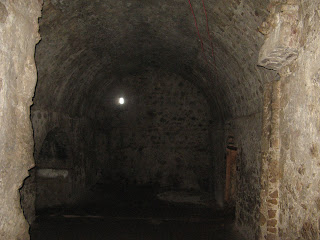Cape Coast, Ghana
Now I’m not one to dodge historic responsibility. I ain’t no racist, neither. White people, Europeans — my ancestors, yes indeed — have done some pretty atrocious things throughout the ages, to each other and to indigenous populations wherever they found them, and I must say the trans-Atlantic slave trade was a doozey to top them all.
But I can’t help feeling that something’s a little off with this slave fortress tour.

Yes I will walk down into the slave dungeons where hundreds of kidnapped men and, separately, women, were cramped into small chambers to fester in their filth for months whilst waiting for a ship to arrive, to take them across the Atlantic to a life of slavery in a mine or on a plantation somewhere in the Americas.

I will offer 5,000 cedis to this cleric sitting at the base of a shrine that commemorates the tunnel to the Door of No Return, where many contemplated and attempted suicide as they passed through to waiting boats. I will snap a photograph of the cleric, too.
Outside I will shake my head in disgust with all the others as the guide explains how the fortress church was built immediately above the dungeons, and the good white folks would pray even as the slaves were led away in chains.

I will walk along the ramparts lined with cannons, learning how the Cape Coast Castle was traded among European powers five times over 13 years in the middle of the 17th century like a chip in a poker game until the British — note, the British, my blood — established naval dominance and used the castle as their headquarters for 200 years, while the slave trade flourished.
I will step inside “The Cell,” where rebellious prisoners were locked without food or water until they simply died, their bodies to be cast into the ocean. I will smell the reek of this place and think of this horrible rotting death and tears will come to my eyes.

And at the end of the tour I will be too ashamed to ask the African guide a question to which I already know the answer: who brought the slaves here?
But this will prove too significant a point for me to leave alone, and I will return later, to ask this question that gnaws through my head, through my heart, and makes me wonder why it wasn’t part of the tour or the museum exhibit.
You see, ‘twas the Africans who brought other Africans here, and sold them into slavery. Contrary to a belief one can’t help but harbour after a tour of the Cape Coast Castle, the European powers-that-were did not delve inland, raiding villages for slaves; they bought them from other Africans and exploited a commodity that was already very much established in this part of the world.
In my opinion, this fact is overlooked by the lore on display at this UNESCO world heritage site.

I cannot imagine walking out of this place with a clear conscience. Anyone would feel the weight of this shame burned into history with the fire of 25 million souls dragged through hell.
But this shame is not reserved for those of us with white man’s blood. It is Africa’s disgrace as well.
Lest we forget. G.
1 comment:
Interested and provocative thoughts, my man.
In East Africa the slave trade was controlled by Arabs, a fact that is noted in the information at the main slave market in Zanzibar.
I guess the thing is, how could people do this to each other? Regardless of the colour of the people with the stick or the people in the chains. It's good to see stuff like that, if only to be shown how low we can all sink.
On a lighter note, get Mike Thomas to e-mail you the Casabooboo video on You Tube.
Cheers, Kiddeos.
Post a Comment